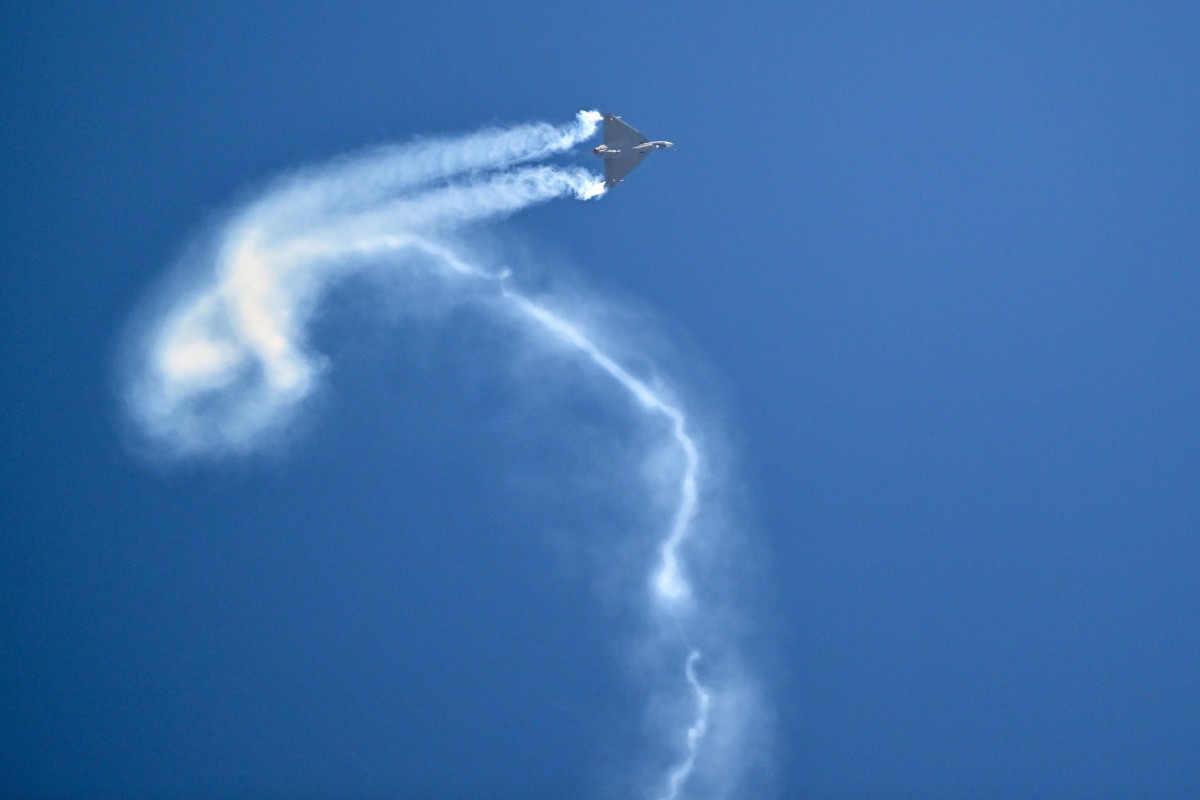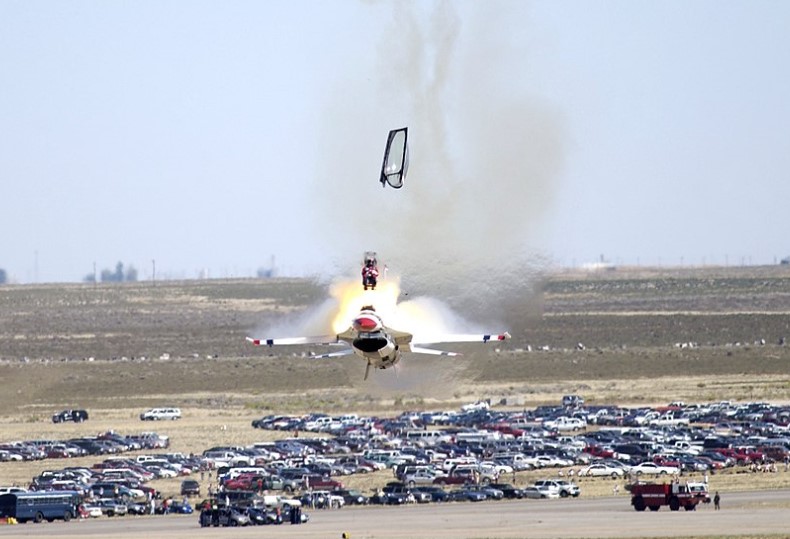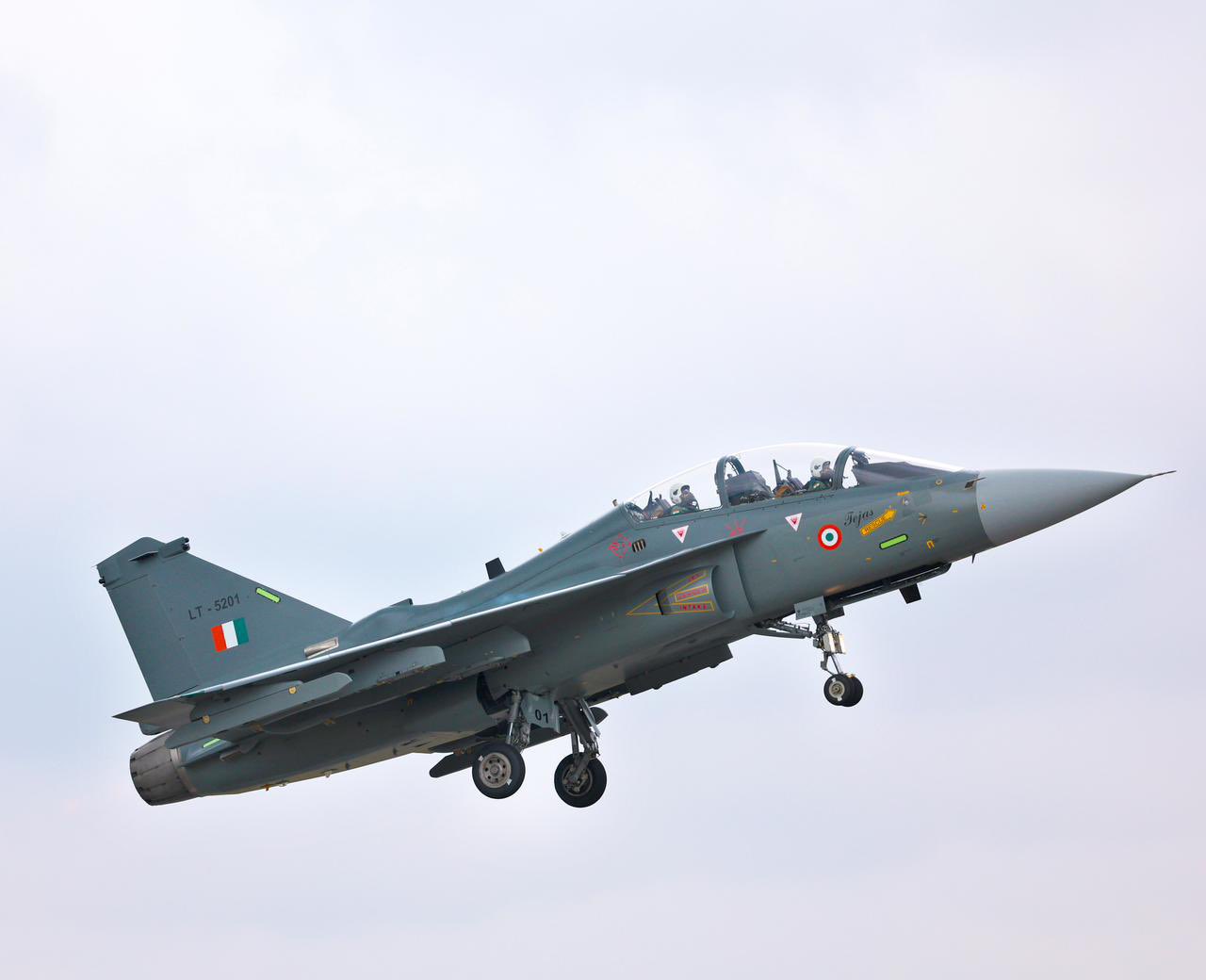In a tragic incident, an Indian Air Force (IAF) pilot died when his Tejas fighter jet crashed during the Dubai Air Show while performing aerobatics.
In videos that have emerged on social media, the IAF pilot can be seen performing a circular loop, a dangerous maneuver in which a pilot flies an aircraft in a vertical circle to return to the starting altitude, only to lose control and crash to the ground within seconds.
The pilot had successfully performed his first circular loop; however, it seems he may have suffered spatial disorientation while repeating the maneuver and lost control.
Spatial disorientation in aviation is the loss of an aircraft’s orientation relative to the earth, caused by a conflict between the pilot’s senses and the aircraft’s actual attitude. It is a major cause of accidents because it can lead to a pilot incorrectly interpreting their position, motion, or attitude, resulting in loss of control.
The jet crashed into the ground within seconds, turning into a fireball.
🚨LCA Tejas Crashes, Pilot Fails To Eject?
When an aircraft is very low, inverted, and descending steeply, ejection is no longer an option — there isn’t enough height or time for the seat to work. Let's wait for the Court of Enquiry: IAF Expert#TejasMk1A #Crash #DubaiAirShow… pic.twitter.com/vnsgzPmD10
— EurAsian Times (@THEEURASIATIMES) November 21, 2025
Unfortunately, everything happened so quickly that the pilot could not eject from the aircraft and died in the accident.
The IAF has ordered a court of inquiry to ascertain the cause of the accident.
“An IAF Tejas aircraft met with an accident during an aerial display at Dubai Air Show, today. The pilot sustained fatal injuries in the accident. IAF deeply regrets the loss of life and stands firmly with the bereaved family in this time of grief,” the IAF said in a statement.
An IAF Tejas aircraft met with an accident during an aerial display at Dubai Air Show, today. The pilot sustained fatal injuries in the accident.
IAF deeply regrets the loss of life and stands firmly with the bereaved family in this time of grief.
A court of inquiry is being…
— Indian Air Force (@IAF_MCC) November 21, 2025
However, notwithstanding the tragedy that led to the death of the IAF pilot and despite the fact that fighter jet crashes while performing aerobatics are not uncommon at all, the incident is set to be used to the hilt for anti-India propaganda.
The international fighter jet market is highly lucrative but also intensely competitive. India was trying to break into this market, so far dominated by a few Western countries, with its indigenous fighter jet, the Light Combat Aircraft (LCA) Tejas, a 4.5-generation plane.
The crash that happened during an international air show, in full glare of cameras and in front of a global audience, will be leveraged to create a narrative that India’s indigenous fighter jet is not reliable.
Several countries, including Argentina, Egypt, Indonesia, Malaysia, Nigeria, and the Philippines, have shown interest in the Tejas aircraft. More recently, Brazil is reportedly mulling a barter deal in which New Delhi would sell India’s Tejas MK1A fighter jet in exchange for the Brazilian Embraer C-390 transport aircraft.
The crash is set to harm these negotiations and future foreign sales prospects for the Tejas fighter jet.
However, aircraft crashes during air shows are not uncommon. They have happened all over the world, and even the world’s most advanced and popular aircraft have been involved in accidents during air shows.

The Long History Of Aircraft Crashes During Air Shows
The history of aircraft crashes at air shows is as old as the tradition of organizing air shows. In the last 100 years, more than 100 aircraft have crashed while performing stunts during air shows.
In 1910, Charles Rolls, co-founder of Rolls-Royce, was killed when the tail of his Wright Model A broke off during a flying display at the Bournemouth Flying Meeting in the UK, causing the plane to crash.

Incidentally, he was the first Briton to be killed in an aeronautical accident with a powered aircraft, and the eleventh person internationally.
In 1988, during the Flugtag Air Show at Ramstein Air Base, Germany, three Aermacchi MB-339 jets from Italy’s Frecce Tricolori team collided during a formation maneuver, with one crashing into the spectator area, igniting a fireball, and killing 70 people (67 spectators and three pilots).
1 min. read
The Ramstein Air Show Disaster, one of the deadliest in history:The Ramstein Air Show Disaster of August 28, 1988, unfolded during the Flugtag '88 airshow at USAF Ramstein Air Base, Germany. The Frecce Tricolori, an Italian Air Force display team, intended to… pic.twitter.com/9rDi2sFdry
— History Unraveled (@luca6290) November 25, 2023
Many times, jets also crashed into the audience, killing many people, including children and aviation enthusiasts.
The deadliest air-show accident in history killed 77 people and injured more than 500 when a fighter jet crashed into the crowd at Sknyliv airfield, near Lviv, Ukraine, on July 27, 2002.
A Russian-made Sukhoi Su-27 was coming out of a tricky rolling dive manoeuvre when its left wing clipped the ground. The jet struck several stationary aircraft before exploding. Twenty-eight children were among the dead.
🧵#OTD in 2002: Sknyliv air show disaster (Ukraine). A Ukrainian AF SU-27 crashes during an Airshow at Sknyliv Airfield (Lviv). 2 crew ejected safely but jet hit spectators. 77 dead, 543 injured: deadliest airshow accident in history. Judicial inquiry pointed to pilot actions.… pic.twitter.com/YpRQlMhJ2z
— Air Safety #OTD by Francisco Cunha (@OnDisasters) July 26, 2024
An inquiry report blamed the pilots – Volodimir Toponar and co-pilot Yuri Yegorov, who suffered only minor injuries after ejecting — for trying to perform the stunt too closely to the ground. Toponar was sentenced to 14 years in prison, and Yegorov to 6 years.
Similarly, on 22 August 2015, a Hawker Hunter plane crashed onto a busy West Sussex road in the UK, during an aerial display, killing 11 people and injuring 16 others.
Footage of the 2015 Shoreham Airshow crash that resulted in 11 people losing their lives. Miraculously, the pilot survived. pic.twitter.com/AfcZ72P4qz
— Morbid Knowledge (@MorbidKnowledge) November 24, 2023
The Lockheed Martin F-16 is one of the most prolific fighter jets in history. So far, more than 4,600 units of the iconic fighter jet have been constructed, and nearly 30 countries fly it. However, even the F-16 has been involved in multiple crashes during air shows or while preparing for them.
In 2020, an F-16 of the Pakistan Air Force (PAF) crashed near Shakarparian, Islamabad, during rehearsals for the country’s Republic Day parade to be held on March 23. The pilot was also killed in the tragic incident.
An F16 of #Pakistan Air Force crashed near Shakarparian, Islamabad during rehearsals of 23 March parade. Rescue teams have been dispatched to site of the crash. A board of inquiry has been ordered by PAF Air Headquarters to determine the cause of accident. @ThePrintIndia pic.twitter.com/1wx0OoPRv6
— Snehesh Alex Philip (@sneheshphilip) March 11, 2020
Also, in August this year, during the Radom Air Show Rehearsal in Poland, a Polish Air Force F-16C Fighting Falcon crashed due to spatial disorientation while flying through low clouds. The pilot also died in the accident.
Additional footage of the Polish Air Force F-16 demonstrator crash this evening in Radom. pic.twitter.com/VORLlCrHiR
— OSINTtechnical (@Osinttechnical) August 28, 2025
Similarly, a US Air Force Thunderbirds F-16C crashed in Idaho while performing during the Gunfighter Skies Air Show. The pilot was able to eject safely and suffered only minor injuries.

In October last year, Charles Thomas “Chuck” Coleman, the famous flight instructor who prepared actors, including Tom Cruise, for the 2022 action movie “Top Gun: Maverick,” died when his Extra Flugzeugbau 300/L plane crashed during a performance at the Las Cruces Air and Space Expo in New Mexico.
This year alone, there have been three more aircraft crashes during air shows, including a Polish Air Force F-16, an Aermacchi MB-326 crash during the West Coast Air Show held in Saldanha, South Africa, and a crash in Australia in March.
This is not an exhaustive list, but it covers only a few prominent crashes during air shows. However, these examples illustrate that aircraft crashes during air shows are pretty common.
The Tejas Story And Safety Record
India started developing its indigenous fighter jet, the LCA (Light Combat Aircraft), in the 1980s.
India’s DRDO (Defence Research and Development Organisation) tasked the Gas Turbine Research Establishment (GTRE) with developing the GTX-37 engine for the LCA. Subsequently, the ambitious Kaveri engine project was sanctioned in late 1989 to power the LCA.
The Kaveri engine failed to meet the requirements; instead of the targeted 81 kN, it produced only 70.4 kN of wet thrust.
However, while developing the Kaveri engine, HAL simultaneously began designing the Tejas aircraft around the GE F404 engine. When it became clear that the Kaveri engine could not replace GE engines, India changed its strategy and decided to design an indigenous fighter jet around foreign-sourced engines.
On January 4, 2001, Indian Air Force (IAF) Wing Commander Rajiv Kothiyal successfully flew the first flight of the Technology Demonstrator TD-1. The then Indian Prime Minister Atal Bihari Vajpayee subsequently named the aircraft the Light Combat Aircraft (LCA) “Tejas,” which means “Radiance” in Sanskrit.
The IAF placed its first order for 20 LCA MK1 fighter jets (Initial Operational Clearance (IOC) standard) in March 2006. This was followed by another order for 20 LCA MK1 fighter jets (Final Operational Clearance (FOC) standard) in 2010.
The IAF has already received 38 of these 40 Mk1 fighter jets. The remaining two Mk1 aircraft are the two-seat trainer variants.
As of August 2025, the IAF operates two Tejas Mk1 squadrons (No. 45 “Flying Daggers” and the No. 18 Squadron – ‘The Flying Bullets’ at Sulur AFS). Subsequently, the IAF placed an order for 83 LCA Tejas MK1A fighter jets for a cost of Rs 48,000 crore ($5.5B) in 2021.

Doubling down on the indigenous jet, India signed another US$7.5 billion contract with HAL for 97 Tejas Mk1A jets in September 2025.
So far, the Indian Air Force has ordered 220 Tejas fighter jets. India is also working on a new variant of the Tejas, the LCA Tejas MK2. In total, the IAF can have a fleet of over 300 LCA Tejas fighter jets by 2035.
Notably, this is only the second known crash of the Tejas fighter jet during its 24 years of operational history since its first test flight in 2001. Last year in March, a Tejas fighter jet crashed in Rajasthan after it was returning from the tri-services exercise “Bharat Shakti”.
Two crashes in 24 years of flying history is not a particularly bad safety record for a new fighter jet.
Fighter jets often suffer crashes and accidents during their early development phase.
For instance, on December 24, 2019, a Su-57, Russia’s latest fifth-generation aircraft, crashed near the Komsomolsk-on-Amur aircraft plant in Russia during a flight test. Notably, this was the first serially produced Su-57.
Similarly, the Pakistani-Chinese co-developed JF-17 Thunder, which flew for the first time in 2003, two years after Tejas’ first flight, has so far suffered five crashes.
So, the Tejas flight safety record is not bad by any standards.
However, given the highly competitive nature of the global fighter jet market, many countries are expected to use the Tejas crash to their advantage and push a narrative that the Tejas is unreliable.
Tejas oil leaks, maintenance lapses, and rushed “indigenous” upgrades were always there — but India dismissed them as propaganda.
Today’s Dubai Air Show crash isn’t shocking. It’s the outcome of ignored faults and inflated confidence.pic.twitter.com/2BZuIrcsz5#Tejas #DubaiAirShow…— Pak-China Today (@PakChinaToday) November 21, 2025
In fact, Pakistan-based social media accounts have already started pushing this narrative. India should aggressively push back against this narrative and highlight Tejas’ flight safety record.
- Sumit Ahlawat has over a decade of experience in news media. He has worked with Press Trust of India, Times Now, Zee News, Economic Times, and Microsoft News. He holds a Master’s Degree in International Media and Modern History from the University of Sheffield, UK.
- He can be reached at ahlawat.sumit85 (at) gmail.com




